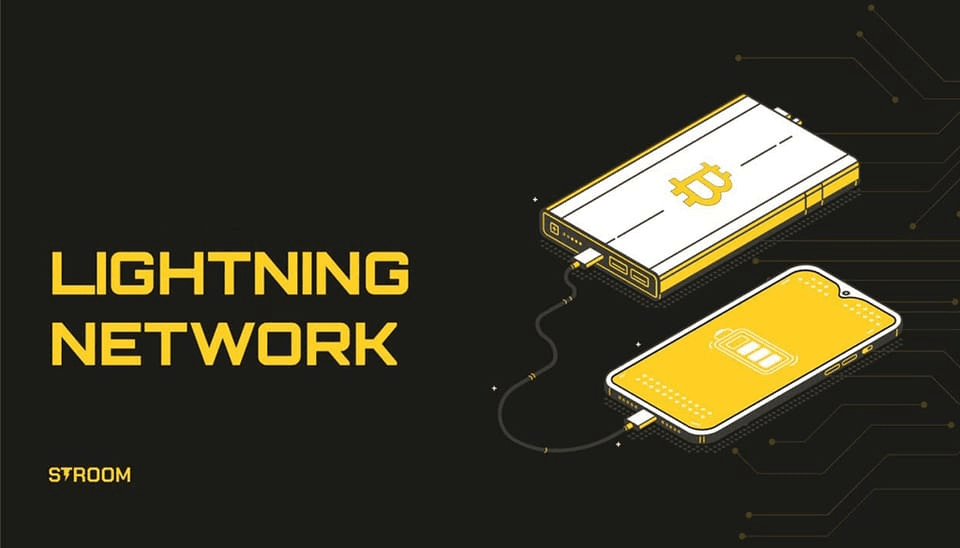Key Takeaways
- Bitcoin Liquid Staking: Stroom enables liquid staking for Bitcoin via the Lightning Network, allowing users to earn rewards without locking up BTC.
- Lightning Network Integration: Enhances Bitcoin’s scalability and liquidity, improving transaction efficiency.
- DeFi Yield Farming: Users can generate yields by participating in EVM-compatible DeFi ecosystems while maintaining BTC liquidity.
- Cross-Network Compatibility: Bridges Bitcoin to Ethereum and other EVM chains.
- DAO Governance: Stroom aims for decentralized governance through its DAO.
What is the Lightning Network?
The Lightning Network (LN) is one of the first Layer 2 solutions created to enhance Bitcoin. Initially proposed in 2015 and launched on mainnet in 2018, the Lightning Network aims to solve Bitcoin’s scalability issues by speeding up transaction throughput and increasing the network’s transactions capacity.
This is achieved via a system of payment channels that connects users synchronistically. Ingeniously, this approach allows for an unlimited number of transactions without each individual one being recorded on the Bitcoin blockchain, meaning only the opening and closing balances of these channels are logged on-chain, significantly boosting scalability and efficiency.
This design means the Lightning Network can be used for instant payments, whether at point-of-sale (POS) terminals, between devices, or for any potential application that requires highly scalable transactions. Lightning’s ability to handle micropayments at low cost opens up numerous utilities for new marketplaces and business models, as Bitcoin’s typical transaction fees are relatively high.
As more users and businesses adopt blockchain and cryptocurrencies, Bitcoin will increasingly need to handle higher transaction volumes. The Lightning Network’s capacity for numerous low-cost transactions is crucial in meeting this continued demand.
Bitcoin L2 Scalability Challenges and the Lightning Network Solution
Since Bitcoin initially launched in 2009, a number of solutions have been proposed to address its scalability inefficiencies. These have includedLayer 2 solutions like sidechains, wrapped bitcoin on Proof-of-Stake chains (such as Ethereum and Solana), and the Lightning Network.
For those unfamiliar, sidechains are external blockchains that piggyback off the main Bitcoin blockchain. However, each sidechain typically has its own security protocols, making them inherently less secure in many respects. Because of this fact, sidechains that hold BTC are more susceptible to potential security vulnerabilities.
In contrast, the LN operates solely on the Bitcoin blockchain, enhancing its security. On Lightning, payments are routed through a decentralized network of payment channels, using 2-2 multisig outputs that are opened and closed on the Bitcoin blockchain. This method allows for a high volume of transactions within a single channel, requiring only two on-chain transactions. Therefore, achieving an environment that is highly scalable and robustly secure.

Boosting throughput on the Lightning Network dramatically increases transaction speeds while positively affecting the broader Bitcoin ecosystem by increasing its overall liquidity and usability. As such, increased liquidity on the Lightning Network enhances scalability, allowing it to manage more transactions as the network expands.
Lowering the technical barriers users face during node interaction will help the LN gain mainstream adoption over time. As more nodes and channels connect to the protocol, increased value accrual will occur within the network, making regular transactions between vendors and users more likely. This interconnectedness is key to the Lightning Network’s continued growth and widespread use.

Introducing Stroom Network
Although not meant to directly increase the scalability of Bitcoin like the Lightning Network, Stroom Network helps increase the Lightning Network’s overall liquidity by enabling DeFi services atop the network. More specifically, Stroom Network is a liquid staking derivative protocol on Lightning Network that operates via EVM-enabled blockchains like Ethereum.
Recall that liquid staking is a recently developed staking paradigm that allows users to earn yield on their assets while ensuring they are liquid and easily withdrawable. This approach lets users, even with small amounts of assets, earn rewards without relying on centralized staking models that favor large token holders.
Typically, when a user deposits their assets into a liquid staking protocol they are given a liquid staking token (LST) which demonstrates ownership (as a digital tokenized receipt) of their staked tokens and any network rewards accrued on those tokens. LSTs can then be transferred, stored, traded, and utilized in decentralized finance (DeFi) protocols or dApps to earn additional rewards.
Stroom enhances this approach because of the fact that it allows users to earn native Bitcoin yield through Lightning Network without locking up their BTC or maintaining separate node infrastructure, ultimately lowering the barrier to entry for new users. In essence, Stroom’s mission is to establish a connection between the Lightning Network and EVM-compatible DeFi ecosystems such as Ethereum.
Therefore, Stroom eliminates the technical complexities users face when depositing BTC within the Lightning Network while simultaneously giving users the ability to participate in yield farming on EVM-compatible DeFi ecosystems.
Looking forward, the Taproot Assets Protocol enables the deposit of assets other than BTC such as stablecoins and others on the Lightning Network, potentially positioning Stroom as a multipurpose yield product that supports a plethora of assets within the Lightning Network.
To summarize, the main objectives of the Stroom Network are to:
- provide a platform that allows users to generate rewards on their deposited BTC
- eliminate the technical complexities of self-hosting a LN routing node
- increase liquidity within the Lightning Network
- provide accessibility to Stroom’s wrapped BTC tokens (stBTC and bstBTC) as a critical component of the DeFi ecosystem
As a participation mechanism, users can deposit their BTC into the Stroom treasury in exchange for stBTC and bstBTC, Stroom’s wrapped assets issued solely on EVM-enabled chains. Once enough staked liquidity is accumulated within the protocol, the Stroom DAO realizes continued connectivity within Lightning Network channels, allowing it to generate yield via Stroom LN node routing fees.
Stroom Network Launch Phases
The launch of the Stroom protocol will occur in two distinct phases.
First, during the "bootstrapping phase," a closed, centralized group of trusted Lightning Network node operators and selected validating nodes will support the bridging platform. These nodes will be chosen through the DAO’s governance process and will include a decentralized BTC-ETH bridge.
In the upcoming "growth phase," the focus will shift to increasing the Stroom platform's decentralization. In this phase, Stroom’s DAO governance framework will manage a distributed network of Lightning Network nodes, which will be initiated in a trustless manner and selected through a specialized KYC process overseen by the Stroom DAO. This phase aims to decentralize the platform further as it matures, with the DAO governing LN node structure.
By adopting a gradual step-by-step launch model, the protocol’s management and development will be continuously governed by DAO members through voting. Validating members will be responsible for approving operations via the treasury using a BFT-style consensus. Conversely, Lightning Network nodes will manage channel liquidity without having direct access to the protocol’s funds.

Stroom Network History and Founding
Stroom Network was initially conceptualized in 2022 and founded by CEO Rostyslav Shvets and CTO Slava Zhygulin.
Rostyslav Shvets completed his bachelor’s degree in applied mathematics and physics between 2010 and 2014 at the Institute of Physics (IOP) of the National Academy of Sciences of Ukraine (Kyiv’s branch of the Moscow Institute of Physics and Technology) before spending two more years at the same university to complete his masters in 2016.
Shortly after graduation, Shvets worked at Bitcoin mining giant Bitfury beginning in 2017 as a product manager and business analyst and later as a protocol architect until leaving the firm in 2020. From there, Rostyslav spent time as a product manager with DeFi pioneer Lido Finance before becoming a product manager at Boosty Labs (which was founded by Stroom co-founder Ihnatiuk) and founding Stroom in 2022.
Slava Zhygulin initially completed his bachelor’s degree between 2009 and 2013 in applied mathematics, physics, and computer science at the Kiev branch of the Moscow Institute of Physics and Technology (MIPT).
Soon thereafter, he moved to New York state to study at Stony Brook University where he completed his master’s degree between 2013 and 2015 in applied mathematics and statistics. Slava went on to complete his PhD in industrial engineering between 2019 and 2021 at the UCF College of Engineering & Computer Science in Orlando, Florida.
In 2015, Slava began a new role with Bitfury as a researcher and analyst where he spent nearly two years researching the Lightning Network prior to leaving the company in 2019. Finally after operating a software engineering startup in 2020, in 2021 Zhygulin worked for Stroom parent company Boosty Labs as a dApp solution architect and Solidity engineer before co-founding Stroom.
In August 2023, Stroom announced it had raised 3.5 million in its seed funding round. The round was led by crypto venture capital firm Greenfield and also included participation from Ankr Network's venture firm, Mission Street Ventures along with contributions from Lemniscap, SMAPE Capital, No Limit Holdings, Cogitent Ventures, and individual angel investors.
Resources
The information provided by DAIC, including but not limited to research, analysis, data, or other content, is offered solely for informational purposes and does not constitute investment advice, financial advice, trading advice, or any other type of advice. DAIC does not recommend the purchase, sale, or holding of any cryptocurrency or other investment.


